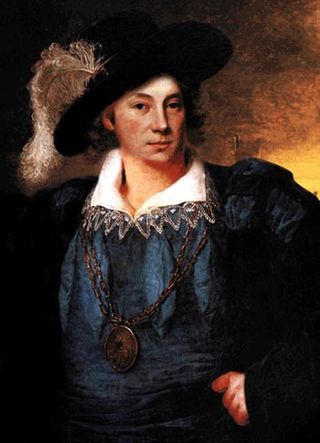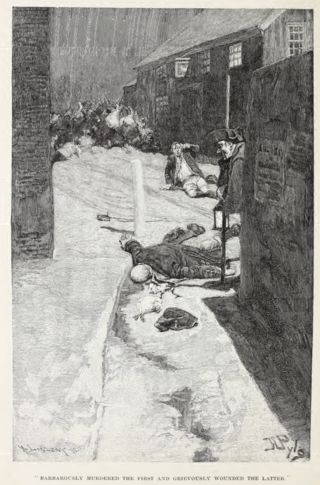Related Research Articles

Edward Teach, better known as Blackbeard, was an English pirate who operated around the West Indies and the eastern coast of Britain's North American colonies. Little is known about his early life, but he may have been a sailor on privateer ships during Queen Anne's War before he settled on the Bahamian island of New Providence, a base for Captain Benjamin Hornigold, whose crew Teach joined around 1716. Hornigold placed him in command of a sloop that he had captured, and the two engaged in numerous acts of piracy. Their numbers were boosted by the addition to their fleet of two more ships, one of which was commanded by Stede Bonnet, but Hornigold retired from piracy toward the end of 1717, taking two vessels with him.

A privateer is a private person or vessel that engages in maritime warfare under a commission of war. Since robbery under arms was a common aspect of seaborne trade, until the early 19th century all merchant ships carried arms. A sovereign or delegated authority issued commissions, also referred to as letters of marque, during wartime. The commission empowered the holder to carry on all forms of hostility permissible at sea by the usages of war. This included attacking foreign vessels and taking them as prizes and taking crews prisoner for exchange. Captured ships were subject to condemnation and sale under prize law, with the proceeds divided by percentage between the privateer's sponsors, shipowners, captains and crew. A percentage share usually went to the issuer of the commission.
Sir John Sherbrooke was a successful and famous Nova Scotian privateer brig during the War of 1812, the largest privateer from Atlantic Canada during the war. In addition to preying on American merchant ships, she also defended Nova Scotian waters during the war. After her conversion to a merchantman she fell prey to an American privateer in 1814. She was burnt to prevent her reuse.

HMS Speedy was a 14-gun Speedy-class brig of the British Royal Navy. Built during the last years of the American War of Independence, she served with distinction during the French Revolutionary Wars.

John Evans was a Welsh pirate who had a short but successful career in the Caribbean.

Laurens Cornelis Boudewijn de Graaf was a Dutch pirate, mercenary, and naval officer in the service of the French colony of Saint-Domingue during the late 17th and early 18th century.

John Halsey was a British privateer and a later pirate who was active in the Atlantic and Indian Oceans during the early 18th century. Although much of his life and career is unknown, he is recorded in A General History of the Pyrates which states "He was brave in his Person, courteous to all his Prisoners, lived beloved, and died regretted by his own People. His Grave was made in a garden of watermelons, and fenced in with Palisades to prevent his being rooted up by wild Hogs."

Van Tuyl is the surname of the Dutch family from which many North American Van Tuyls, Van Tuyles, Van Tyls and Van Tyles are descended. The family name derives from the ancient village of Tuil (Tuijl), in the central Netherlands. The family's earliest proven ancestor is the 14th-century knight Heer Ghijsbrecht van Tuyl of Gelre. This family is distinct from the Van Tuyll van Serooskerken family.
HMS Raposa was the Spanish brig Raposa, launched in 1804. She was captured A cutting out expedition in 1806 by boats from HMS Franchise in the western Caribbean captured her. The Royal Navy subsequently took her into service under her existing name. Raposa served in the Caribbean, repeatedly recapturing merchant ships that had fallen victim to French privateers. Thirteen months after being captured she ran aground while pursuing enemy ships. When they were unable to refloat Raposa, her crew set fire to her to avoid her capture, destroying her.
John Hoar was a pirate and privateer active in the late 1690s in the Red Sea area.
Thomas Mostyn was a sea captain and slave trader active between New York and the Indian Ocean, and later in the Caribbean. He was one of the traders employed by New York merchant Frederick Philipse to smuggle supplies to the pirates of Madagascar.
Peter Lawrence was a Dutch pirate and privateer active off New England and Newfoundland, and in the Caribbean. His and other pirates’ dealings with Rhode Island’s governors nearly led to the colony losing its charter.
Regnier Tongrelow was a prolific privateer who operated out of New England. He captured a large number of ships over a short career, sending most back to New York, and was known for attacking the largest ships he could find.
Nathaniel “Nat” Burches was a privateer who operated out of New England. He was known for sailing alongside Regnier Tongrelow and Thomas Penniston, and for single-handedly defeating a huge Spanish ship.
Adrian Claver was a Dutch privateer based out of New England. He sailed alongside other prominent privateers such as John Halsey, Regnier Tongrelow, and Thomas Penniston.

Captain Gincks was a privateer based in New York. He is best known for sailing alongside Adrian Claver, and for a violent incident involving his sailors while ashore.
Captain Crapo was a French privateer active in the Caribbean and off the American east coast during the War of Spanish Succession. He was highly successful, capturing a large number of English vessels which he sent back to his home ports in Martinique and Port Royal.
Captain Davy was a French privateer active off New England during Queen Anne’s War. He is best known for repeatedly evading capture by rival English and Dutch privateers including Adrian Claver and Thomas Penniston.
David Williams was a Welsh sailor who turned pirate after being abandoned on Madagascar. He was only briefly a captain, and is best known for sailing under a number of more prominent pirate captains.

Giles Shelley was a pirate trader active between New York and Madagascar.
References
- ↑ First name also Tom, last name occasionally Pennistone or Peniston.
- ↑ Marley, David (2010). Pirates of the Americas. Santa Barbara CA: ABC-CLIO. p. 562. ISBN 9781598842012 . Retrieved 8 November 2017.
- ↑ "The History Box |Newspaper Correspondence 1704-1708 Part I". thehistorybox.com. Retrieved 8 November 2017.
- 1 2 3 Groenendijk, R. L. Van Tuyl and J. N. A. (1996). A Van Tuyl Chronicle: 650 Years in the History of a Dutch-American Family. Decorah IA: Rory Van Tuyl. pp. 128–129. Retrieved 5 November 2017.
- ↑ Wilson, Rufus Rockwell (1902). New York: Old & New. Philadelphia: J.B. Lippincott. p. 132 . Retrieved 8 November 2017.
- 1 2 3 Alden, Henry Mills; Allen, Frederick Lewis; Hartman, Lee Foster; Wells, Thomas Bucklin (1895). Harper's (Volume 90 ed.). New York: Harper's Magazine Foundation. pp. 335–339. Retrieved 5 November 2017.
- ↑ Manhattan Company, Bank of the (1915). SHIPS AND SHIPPING OF OLD NEW YORK. New York: Walton Advertising and Printing Company. p. 27. Retrieved 5 November 2017.
- ↑ Fletcher, R. A. (2013). In The Days Of The Tall Ships. Worcestershire UK: Read Books Ltd. ISBN 9781473383456 . Retrieved 5 November 2017.
- ↑ Lincoln, Charles Zebina (1894). The Colonial Laws of New York from the Year 1664 to the Revolution, Including the Charters to the Duke of York, the Commissions and Instructions to Colonial Governors, the Duke's Laws, the Laws of the Dongan and Leisler Assemblies, the Charters of Albany and New York and the Acts of the Colonial Legislatures from 1691 to 1775 Inclusive. Clark NJ: The Lawbook Exchange, Ltd. p. 958. ISBN 9781584775966 . Retrieved 8 November 2017.
